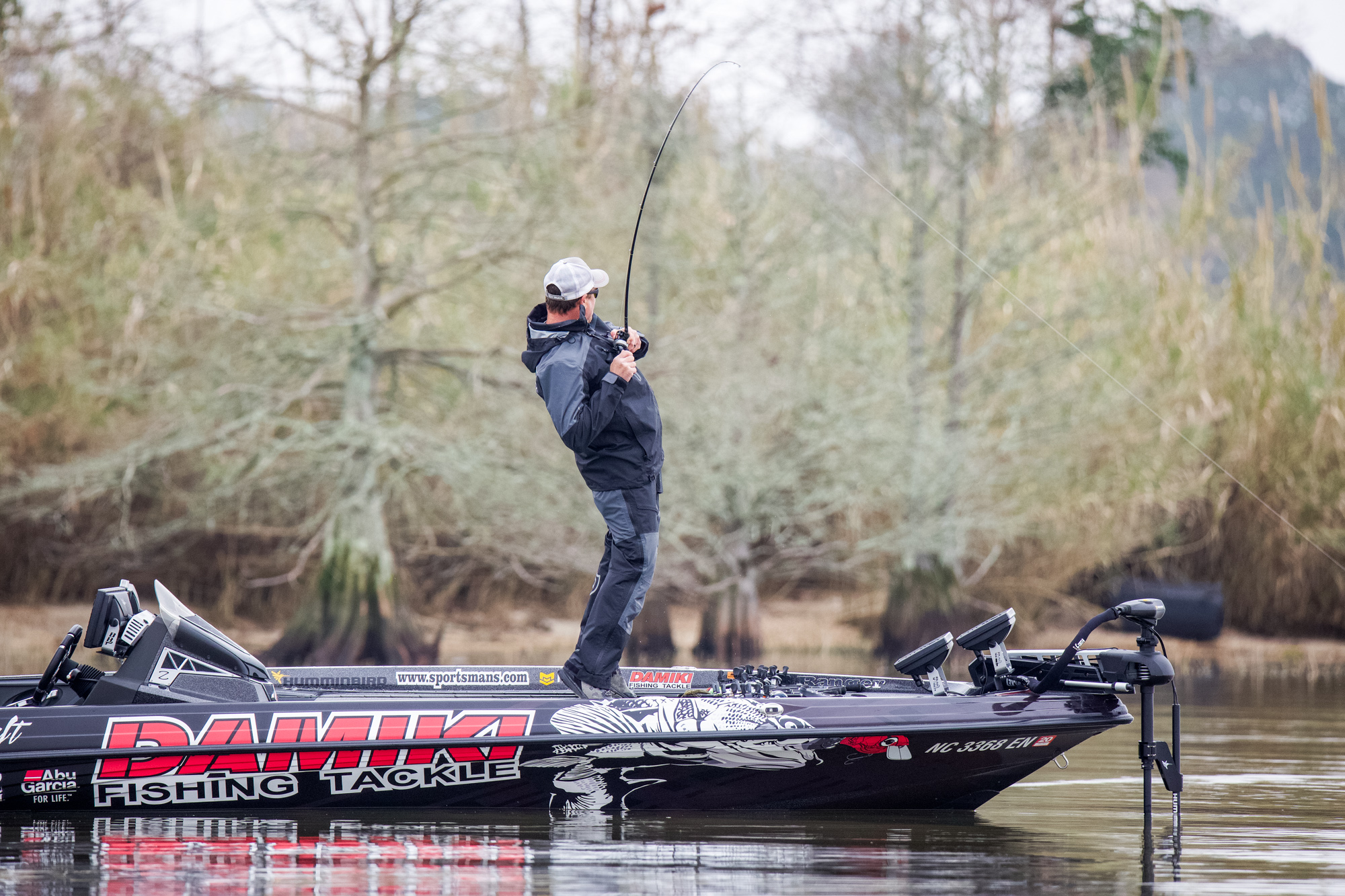Thrift Prepares for Cooling-Water Window with “Best Topwater Fishing of the Year”

With winter only weeks away, topwater lures tend to get little play on waters north to south.
For MLF pro and 2019 Forrest Wood Cup champ Bryan Thrift, however, the prospect of drawing surface strikes from bass in the late season is cause for excitement.
“Some of the best topwater bites I’ve had have been right before the first cold front of the year,” says Thrift, who makes his home in Shelby, North Carolina. “If you follow the weather patterns and your water temperature is in the mid-60s and you see a major cold front or your first frost of the year, those last two or three days before the cold hits can provide some of the best topwater fishing of the year.”
Two Topwater Trains of Thought
Thrift follows two trains of thought in formulating his late-season topwater strategies. The first is a “covering the water” bite with fast-moving lures like a buzzbait or a plopper-style lure. The second involves a more patient approach, presenting topwater lures to schooling fish locked in on a baitfish concentration.
The dividing line for those two bites is water temperature.
“In my region of the country, the Carolinas, the last 60-degree water temperatures is your last opportunity for a topwater bite as far as the moving bait pattern goes,” says Thrift. “The schooling fish bite will progress further along because it’s not temperature dependent. It’s bait dependent!”
Thrift has taken schooling bass on topwater lures in December and January with water temperatures in the low- to mid-50 range.
The “Giddy-up” Bite
The days preceding the first frost or major cold front are prime time for fishing fast-moving topwater baits.
“When I’m doing this type of fishing, I always have a buzzbait with a Zoom Horny Toad and a (River2Sea) Whopper Plopper on my deck,” says Thrift. “These are baits I can throw a long way and can wind really fast. I want to work fast and cover water with my trolling motor running at 80 percent. They’re baits I can fish at that speed effectively with a high-speed retrieve, making super-long casts.”
Thrift thrills to this late-season opportunity, calling it his “perfect topwater bite.” He revels in the speed, excitement and unpredictability of putting a big, churning topwater bait in front of as many big fish as possible.
“The cool thing about this approach is that you can get a bite at any portion of the cast — right against the bank, on a straight stretch of rip-rap, or right beside the boat just before you lift the lure out of the water. You’re after fish that don’t really have a home. They are just up feeding, being opportunistic during that last warm water spell before the frost.”

The Patient Approach
Bait-oriented bass in late season are apt to locate over brush piles or some type of cover or structural element or corral bait in pockets or portions of creek arms.
“You pretty much have two groups of fish,” says Thrift. “The first group stays on the main lake — on points, humps, maybe main lake grass. The other group of fish follows shad or other baitfish into pockets, creek arms, things like that.”
Locating the fish requires a more attentive, patient angling approach.
“You can’t eliminate any portion of the lake,” says Thrift. “You have to move around and look into all the nooks and crannies to find that group of baitfish and the group of bass schooling on it.”
Finding the fish can be tough, but the payoff can be huge.
“Once you find them, it can really be fun,” says Thrift. “Often you can park and catch fish for two or three hours. The key then becomes figuring out what type of presentation and type of bait it takes to catch them.”
Scaling it All Down
More often than not, Thrift’s answer in the winter is a smaller popper/chugger-style bait or compact propeller bait.
“If I find a group of bass in the back of a pocket in 3 feet or so of water, my ‘go-to’ bait is a Damiki D Pop (70),” he says. “It’s a small Pop-R-style topwater bait. I can more or less work it in place and make those fish commit to it. They have the bait corralled. They won’t leave because the bait is there. You just need to force them to bite.”
Smaller topwater like the aforementioned Damiki D Pop or even an “old school” bait like the Heddon Tiny Torpedo are proven producers in this late season, primarily because the bass are targeting young shad, often threadfin, hatched earlier that season.
Thrift designed the 6-foot, 3-inch Finesse Topwater rod in Fitzgerald Rods’ Bryan Thrift Series to facilitate presentation with smaller topwater baits. He mounts it with an Abu Garcia Revo MGXtreme reel filled with 10- to 12-pound P-Line Topwater, a new highly buoyant, low memory copolymer line released last January that factored into Thrift’s 2019 Forrest Wood Cup victory.
To dial in on the most effective presentation, he first tries to determine whether the fish are using any cover or structural elements in the area or if they’re strictly relating to the school of bait itself.
“If I see fish busting bait in a pocket, a lot of the time the easier bites will be concentrated around cover — say a laydown or a shallow dock, something like that,” he says.
Given his druthers, however, he’ll take the bite of bass randomly feeding on a heavy baitfish concentration.
“At times, they aren’t on structure but just in the middle of the pocket or following the creek channel, feeding on shad on a 3- or 4-foot-deep flat in the middle of nowhere,” he says, breaking into a grin. “That’s the ‘funnest’ bite because you don’t have a target. You’re just fishing aimlessly and getting bit everywhere!”